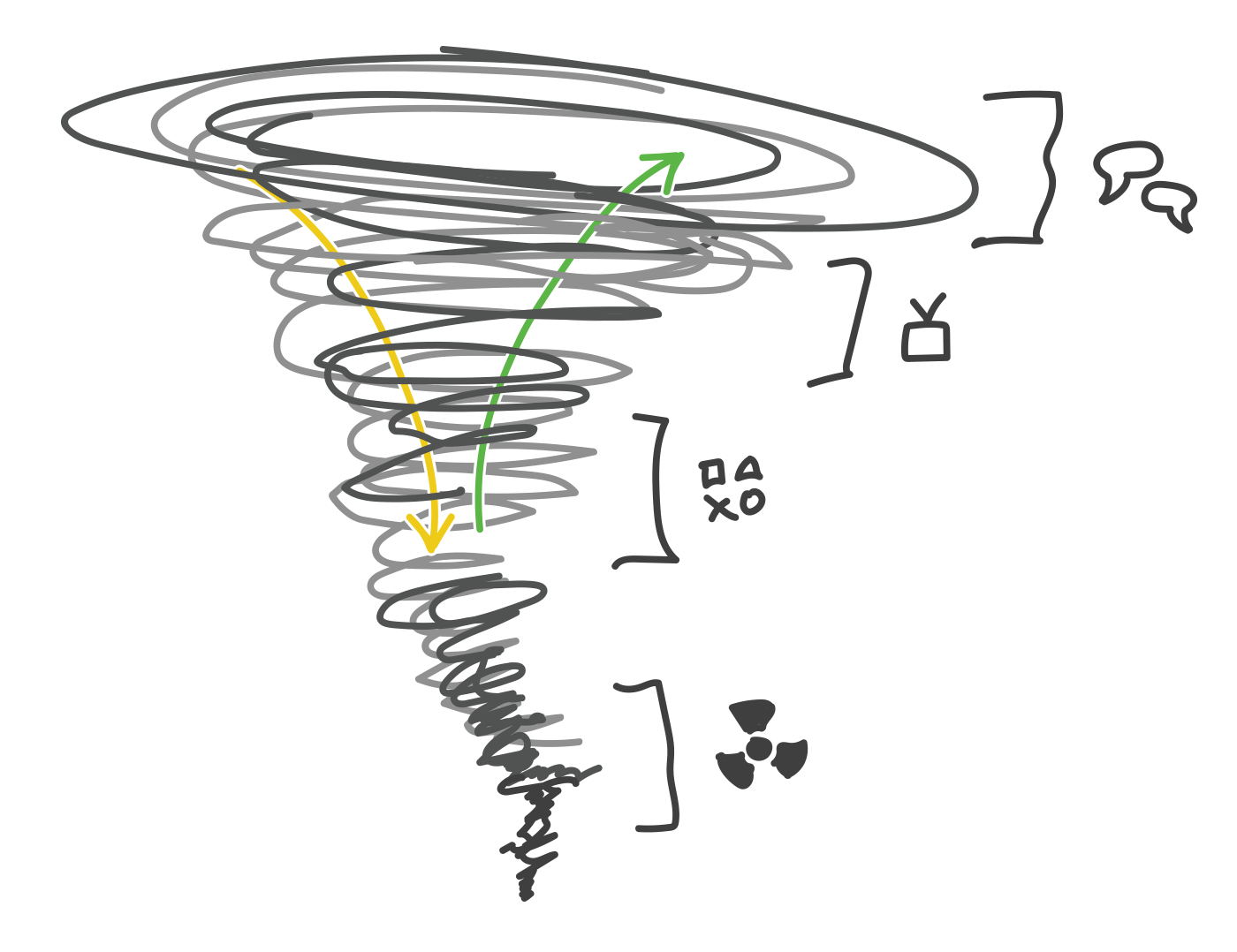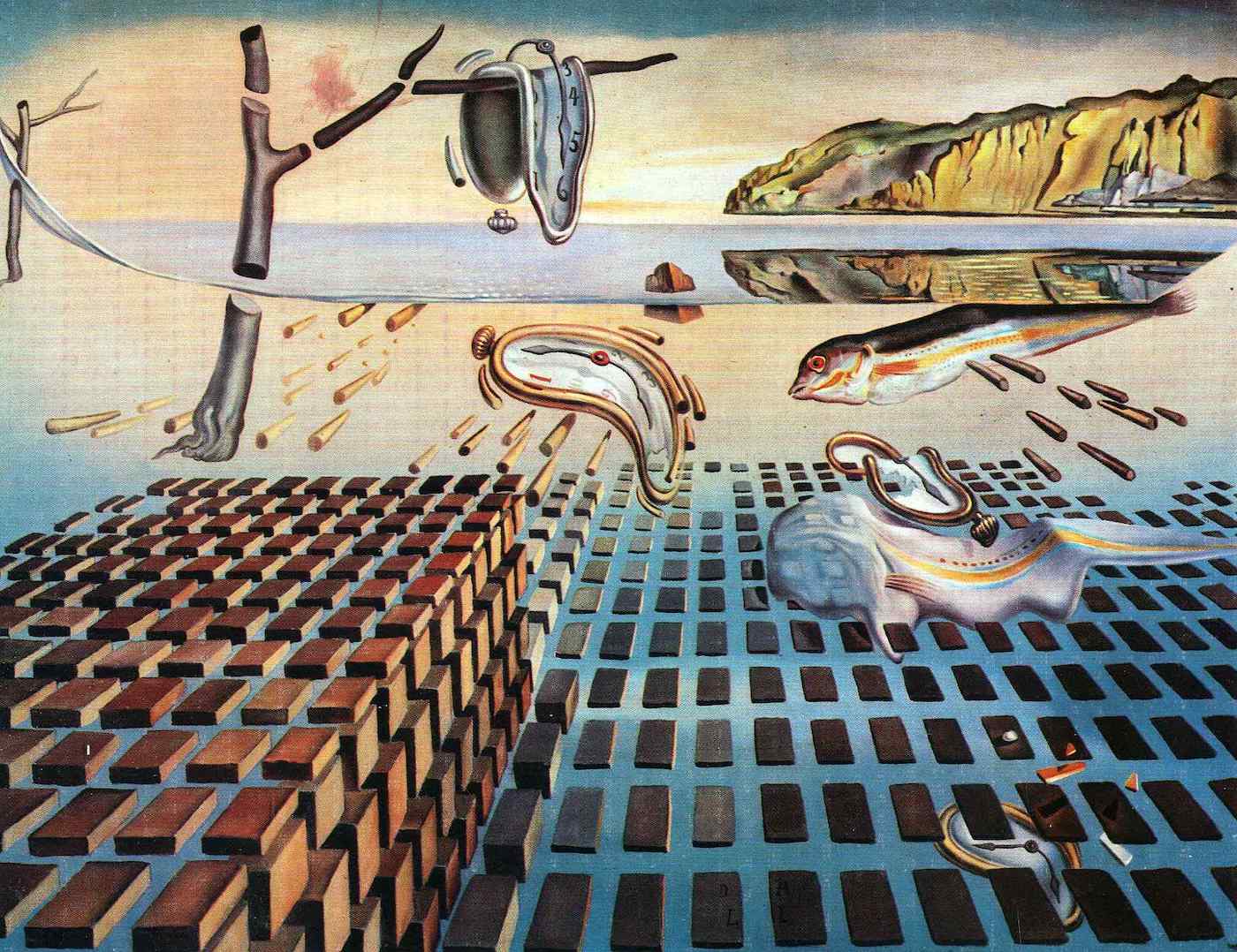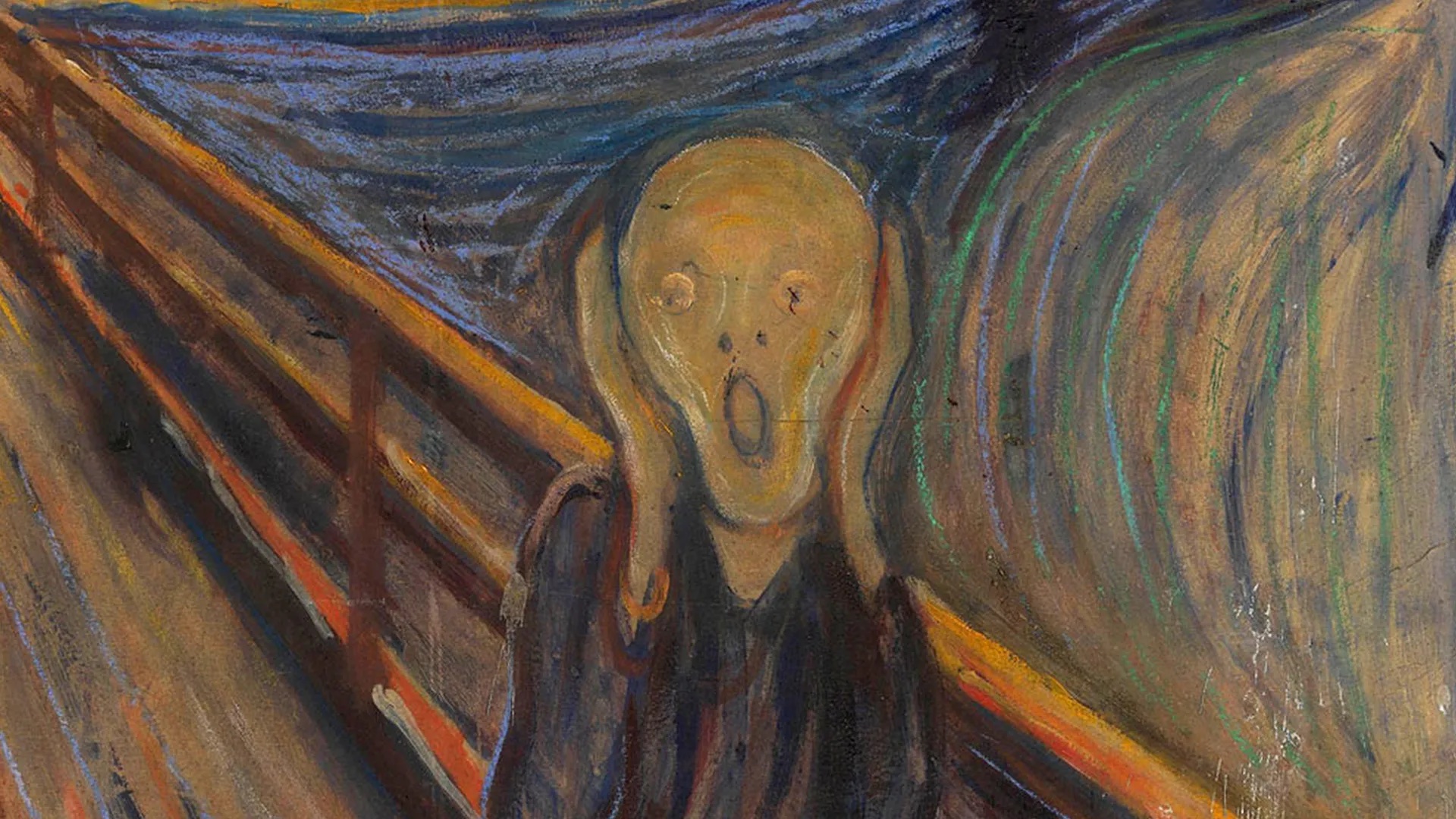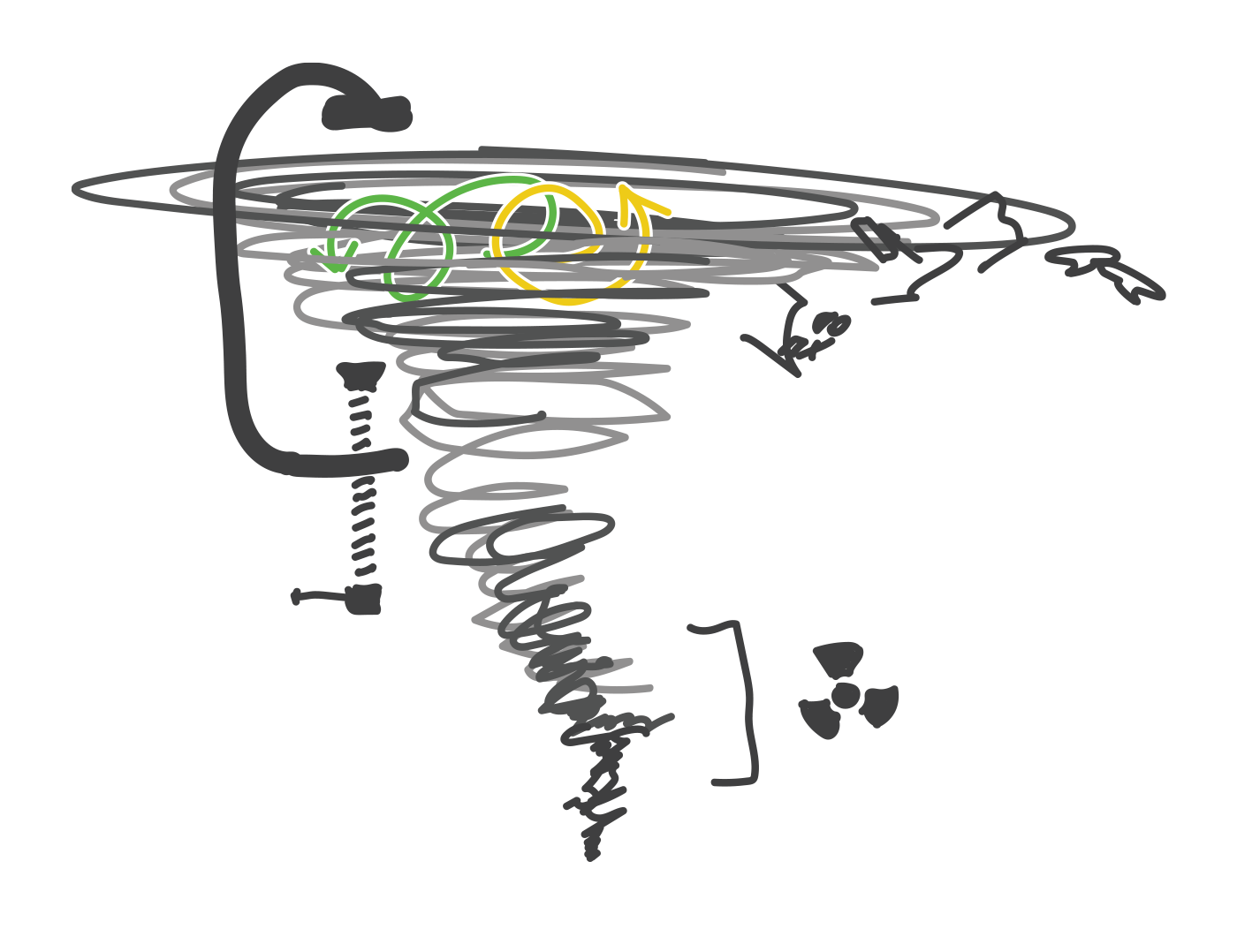Upon the most recent medical assurance that I had more than a few months to live, I was more relieved than I expected to be. Having no obvious death wish, I found myself struggling to describe why I was so unburdened and why I didn’t notice what I was carrying around in the first place.
Thus was born the anxiety vortex.

Although it may look like an undifferentiated and inevitable descent into personal crisis, I find it useful to divide it into four distinct regions. Starting from the top:
The Rim

The topmost level is work. This a job, bills, social events, transportation, dating, burying evidence, walking the dog, etc. A career and its attendant ills eat the majority of this area for most people, but it isn’t primarily about income generation; it’s the connection to the rest of society. It’s other people,1[1] and all the interface maintenance required to exist around them and whatever they’re most upset about today.
Ever since social engineering started roping together more than four or five digits’ worth of individuals, this level has been humans’ primary area of study. This is reasonable, because it’s difficult to keep large numbers of people caring about the same things at the same time and we’ve convinced ourselves that that’s a good idea, so we need to keep up on the research.
As it relates directly to anxiety, the rim contains stressors that only exist in relation to external desires and constructs. This is also the part we complain about the most, as it comprises by definition most of what we have in common with each other.
The Wheel

Since we don’t climb directly into charging pods at the end of the workday,2[2] there’s a slew of other things we have to do: dusting, laundry, eating, self-care, self-destruction, meditation, masturbation, exercise, reading, crosswords, going to the bathroom, staring at the ceiling, and determining if the most recent unexpected noise is scary enough to warrant investigation or too scary to be worth investigating.
The wheel is where the mundanity of life must be maintained: the necessary operations of mind and body to retain health and sanity that go unnoticed by the external world until neglected for extended periods. It can take up as much or more mental energy to manage than the rim, but doesn’t make for lively conversation until you’re on reasonably intimate terms with the audience.
There’s a hazy line between the wheel and the rim, but a good rule of thumb is it’s not on the wheel if you can imagine Lex Luthor doing it. Eating can be a social event, so dining out, yes; ordering fried rice, probably not. Reading, maybe. Taking a dump? No. Taking a leak? On an enemy, maybe. Doing laundry? Absolutely not.
This is where spiders live. Sure, most spiders are an objective good to health and safety, but do you want to share your home with an eight-legged deathtrap architect? The situation can be handled or ignored, but it exists, and nobody can help you.
The Core

It’s not only that people generally don’t talk about core anxieties: It’s nearly impossible to properly communicate them. This is “who am I, really?” territory. You can brush it off with a sufficiently German word in casual conversation, but this is where the lifelong summation of individual subjective existence refuses to sum up. It’s the murky, ever-evolving sludge of identity, inexpressible fears, desires without objects, important thoughts that take hours to explain and change during the explanation.
Entire religions and philosophies exist to deny existence of or defer responsibility for this part of being alive. It also contains most of the backdoors exploited by cults, scammers, and magicians. It’s difficult to manage with nuance, and most prefer to distract from it with wheel and rim management, or deny it altogether if rim problems are ostensibly under control. That core anxieties can, in fact, be managed with outright denial makes them even harder to talk about for those who can’t or won’t take that approach.
The core is why therapy exists, and where Dostoevsky books come from.
The Abyss

Mortality. Infinity. Nothingness. The size of the cosmos. The mind of God. The incomprehensible things that intrude on us if we dare to imagine the possible shapes of reality outside our tiny slice of it. Blanket denial is the only acceptable management tool, even—or perhaps especially—for those who sneak out for whippets of the ineffable.
The more you know, the deeper the abyss gets. You become better and better equipped to understand exactly how humble a mote is the human mind, floating in a tidal pool of maddening complexity next to an ocean of the unimaginable. Bad enough I can’t figure why my phone keeps switching to focus mode; now there are multiple working methodologies for determining truth and the physicists misplaced nine tenths of the universe.
People often mistake core anxieties for abyss anxieties, and so forget the abyss exists. This is good, because the problems of the abyss cannot be managed or overcome in the manner of other anxieties. The only solution is editing them out of day-to-day existence by whatever available means, forgetfulness being as good a method as any. This is the realm of the unknowable, where Stanislaw Lem lurks in every shadow, pointedly not jumping out at you.
Armed with this near flawless blueprint of the human soul, a variety of cultural oddities make sense. Escape trends upwards and outwards: if core anxieties become unmanageable, one is told to focus on taking care of oneself, i.e., to attend to anxieties in the wheel. When the wheel turns to drudgery, people are encouraged to spend time with friends and family out on the rim. For true escape artists, the outer edge of the rim is where the fun brain drugs live.
Repair trends downwards. If social and professional obligations are in disarray, advice will again start with taking care of things down in the wheel, and if you can’t get that started, get thee to a psychologist. The inner edge of the core is where the prescription brain drugs live.
The borders are porous, but it is important to avoid compression. Take, for instance, the workism vice:

Sagittal MRI scan courtesy of Penn Medicine.
A workism vice isolates the professional component of the rim and ties it to management of the core issues. The outer manifestation of this perversion is LinkedIn articles about making spreadsheets to manage friendships, or how quarterly reviews can keep the spark in a romance. All wheel and rim concerns get crushed into this career-as-identity pressure. Workism is only the most comical obscenity: Any prescription suggesting a scaffold of fundamental self-worth can be built on a facet of social interaction creates this artificial collapse. Local coping strategies are incompatible between their regions; poetry doesn’t get you to the office on time and birthday parties don’t explain why you cry when you see baby porcupines. Escape and repair movements become impossible because they loop back on each other in a knot of all nameable anxieties, slowly tightening over the abyss.
Emphasizing the multi-regional nature of anxiety also explains why, in our more stable moments, general purpose mantras for life seem so instantly vapid. “Early to bed and early to rise” does not in fact solve the majority of life’s concerns as much as it describes a wheel-centric coping strategy for a minority of the population. “Seize the day” is possible succor for the core anxieties of a student at a private boarding school; less so for someone working two jobs to cover rent. Everyone has a personal distribution of concerns across the vortex, and a unique set of strategies for navigating among them.
Finally, this illustration helped me diagnose a classic problem.
Since I reached an age and position in life where I am both capable of managing my own healthcare and in constant need of it, it has produced anxieties across the spectrum. Rim anxieties about phone calls and scheduling, wheel anxieties about diet and excerise, core anxieties about my relationship with my body. All of these are more or less manageable.
Until the errant test result puts something like cancer or major organ failure on the table. Then there’s a shortcut between the rim and the abyssal anxiety of death.
Rim anxieties are ultimately conquered by acknowledging and dealing with them: make the phone call, write the paper, plead guilty. Unfinished rim tasks steadily increase anxious pressure, requiring more mental resources as they simultaneously become more worthy of concern and harder to acknowledge. Having a link between a mundane task and a primal phobia cranks that pressure up to a mile below sea level and falling, since facing up to the task requires glimpsing that which cannot be dealt with and must not be acknowledged. This exploding allocation of psychic energy then gets poured straight into the abyss in the hopes of jamming the connection long enough to call a doctor’s office and listen to all the options because their menu has recently changed.
My frustration with middle age is that this mental construction has gone from an unhealthy thing avoided via therapy and life affirmation to an annual hurdle akin to filing taxes. Allowing the abyss to intrude into daily life was what my doctors used to call a panic disorder, and something it took decades of effort to bury deeply enough that I could get through life without punching myself in the face every other day. It feels unfair that it gets to Pet Sematary me every few months, due to nothing more than the natural progression of modern life.
Not too late to join a cult, I suppose. In the meantime, even if the abyss itself resists cartography, mapping the paths to its edge drags some of its dread into the realm of the comprehensible and manageable, and the mortal scream can be downgraded to subtle twitches and an occasional gasp.





